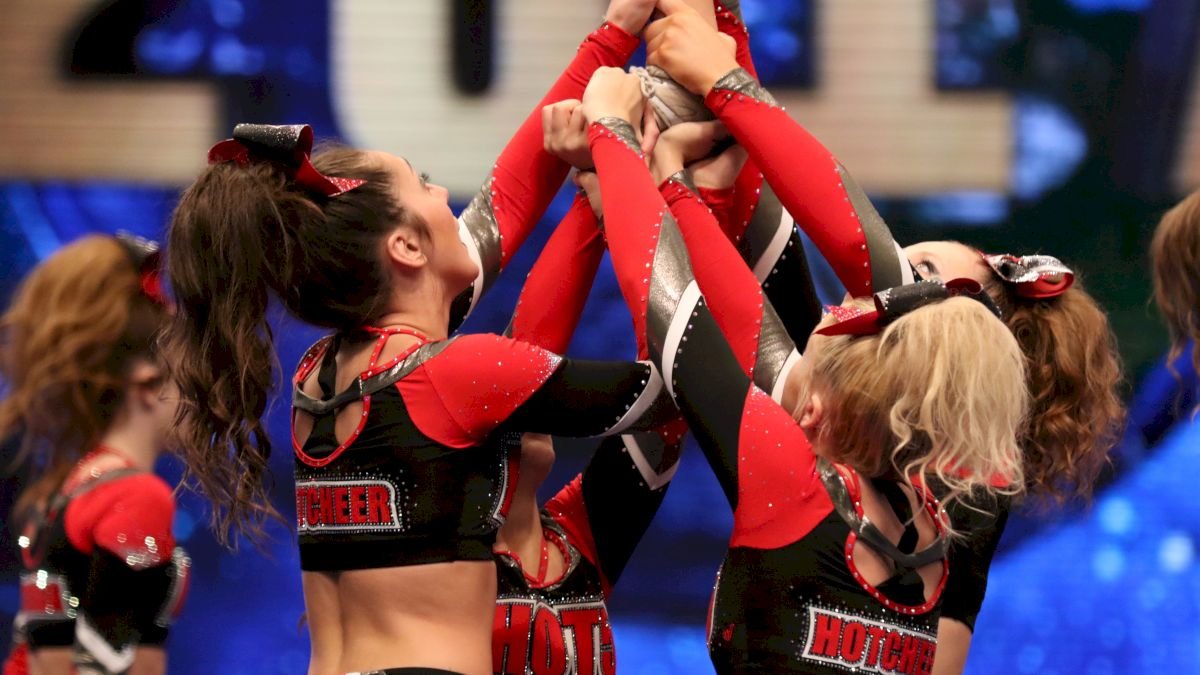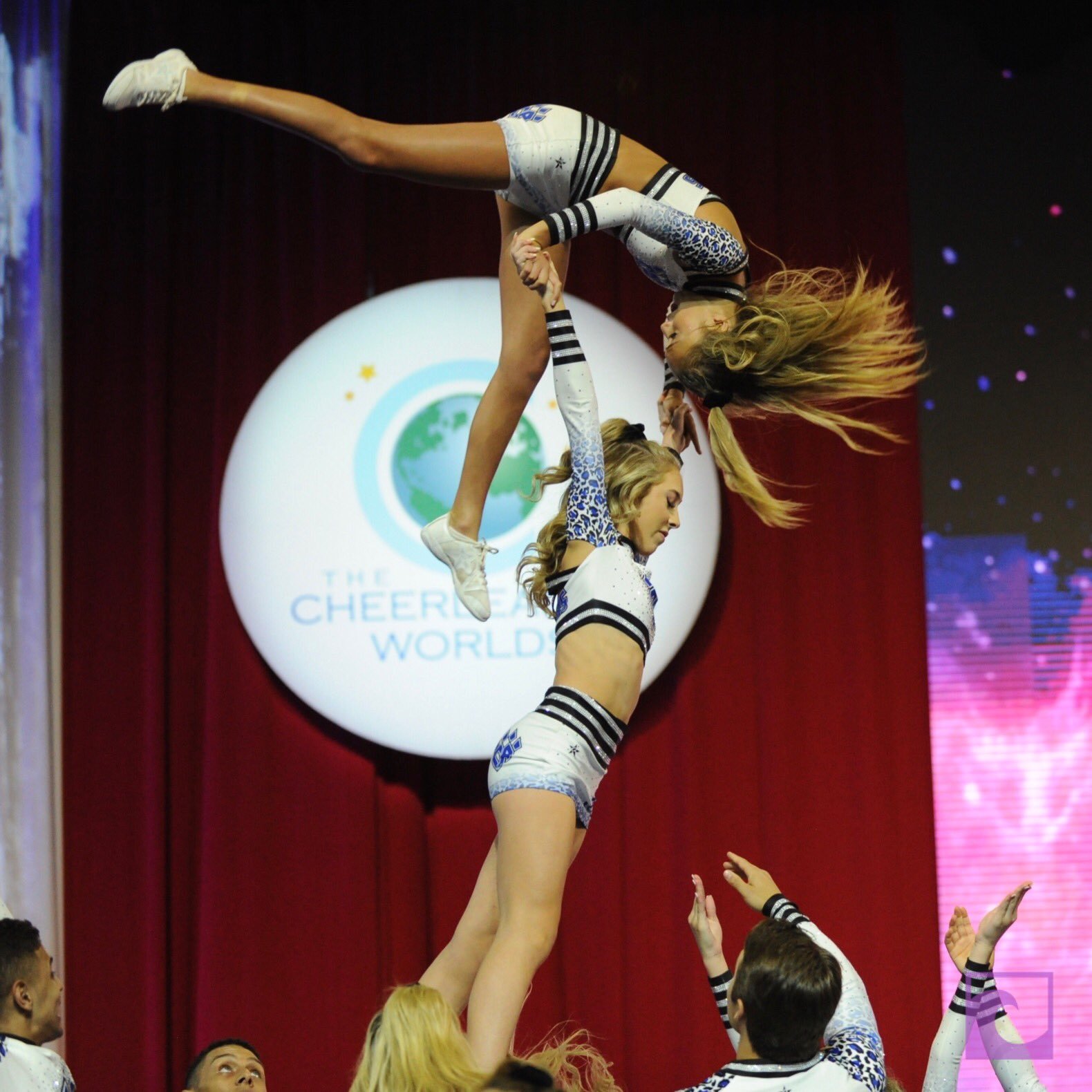How to Become a Better Stunter
Pyramids are the flashiest part of most cheer routines and also the most dangerous if done incorrectly.
Stunting, the core skill of cheerleading and easily the most challenging. It requires teamwork, strength, technique, and above all, trust. Many teams will struggle to ever hit their dream stunts because they don’t train or focus on the right aspects of the stunt. Not to mention that incorrect stunting can quickly lead to injuries. In this article, we will break down stunting through each position to see how a person can individually improve their skills.
Bases: The Foundation
Flyers put the weight of their trust (and body) in the hands of their bases.
The bases are the foundation that builds a stunt, for the flyer relies on a strong platform to stand on, and the backspot needs to understand the style of their group’s basing. The two main components of a strong base are strength and technique.
Strength
Being strong is so important to achieving high level skills, for bases are in charge of lifting a girl above their heads and then holding them there. However there is a misconception that basing is done with the arms, and that is simply not true. Having strong legs adds more power behind the stunt. Having the majority of the flyer's weight sit in the base's legs can prevent back injuries and also give the stunt more control overall.
To improve leg strength, exercises such as lunges, squats, and weightlifting can be extremely beneficial to a base. Arms are not to be disregarded as a whole, however, for they are still important to maintaining a firm and powerful hold. Pushups and weightlifting are common exercises that are simple and easy but still lead to results.
Technique
If one lacks technique, most stunts won’t look perfect, regardless of a group’s overall strength. To be successful requires an understanding of how each position works. For bases, the number one goal is speed. By being quick in the dip and driving fast to the top, it maximizes the weightless period the flyer has. This creates that gorgeous floating visual that makes cheerleading so appealing, and it doesn’t even rely on brute force. Instead, it’s a clever application of gravity.
With great speed comes great trust in both bases, so it is imperative that the bases “lock in” with each other’s timing. If one base moves faster than the other, then the flyer’s legs will be uneven causing her to have a harder time balancing. Many coaches will tell bases to lock eyes or to watch the foot in the other bases hand, whichever works for each pod. Once the stunt reaches its final position, bases should be shrugging through their shoulders and standing chest to chest. Engaging in the stunt and keeping all members close together helps stabilize the stunt and keep everything in place.
The best way to improve technique is to practice, practice, and practice some more. Perfecting the basics BEFORE moving on to the harder skills will ensure that all the small movements are ingrained in the group, thus making building new stunts in the future much easier.
Backspots: The Support
If the bases are the foundation, that means the backspot is the support. They provide safety to the flyer by always having at least one hand on her, while also providing stability for the bases by constantly pulling up. Typically, the backspot leads the stunt, but they also provide a better visual of what is happening within.
Strength
Backspots should focus on improving their upper body and core strength. This helps them pull the stunt up and keep it in place. Studies have shown that pull-ups, deadlifts, and rows help mimic that “pulling” feeling, but weightlifting in general is already beneficial.
Technique
Within backspotting, technique is most important. If a backspot isn’t pulling up, the stunt will move around and be very unstable. One tip many backspots recommend is when grabbing the flyer's ankle, have the pointer finger pointed upwards. Once you start pulling, it engages your hand upward more than forward or sideways, driving most of your energy upward. On the topic of ankles, backspots should always be the first to touch the flyer and it typically is at the ankle. Just like bases, speed is key; the faster the backspot makes contact, the sooner they can pull upwards and relieve the weight off the bases.
Lastly, a backspot’s greatest piece of technique is building trust. A backspot can feel and see all aspects of the stunt, from the flyer’s balancing point to the levelness of the dip. Learning how to kindly bring up corrections and issue possible solutions is an unwritten job of a backspot, but sometimes the first step is feeling comfortable within your group to speak up!
Flyers: The Show
TGLC is one of the strongest cheer gyms in the US and their flyers are capable of doing a multitude of athletic feats.
Lastly, we have the flyers. Flyers are the billboard of a stunt, and if something goes wrong then the flyer’s job is to hide it to the best of their abilities. Having stellar showmanship and facials can add to the performance quality of the stunt and, coupled with insane flexibility, can truly create a flavorful routine. Being the flyer is almost every cheerleader’s dream at some point in their career, yet only a few only ever get to experience it. Even fewer get to keep their position forever.
Strength
Strength is important, but for flyers flexibility comes first. Being able to pull body positions correctly and safely requires flexibility in almost all areas of the body. Hamstrings and hip flexors can inhibit a heel stretch from looking pretty, whereas scales and needles rely heavily on back flexibility. Stretching daily is a must to ensure that your body is capable of these positions without injury.
Having a strong core is the second most important piece of strength. Holding your hollow in baskets and cradles helps prevent injury for the bases and also ensures that you fold through their hands. Hollow rockers, ab circuits, and pilates can help build the bodily awareness that makes holding your hollow easier.
Technique
A flyer’s main technical job is to make the stunt look easy. This means not wobbling in the air, flailing their arms, and not looking terrified. Confidence is key when it comes to most of these. In fact many flyers are told to “do less” when in the air if things start getting funky. The more a flyer panics and moves, the harder it is for the bases to adjust and fix the problem. This requires a lot of confidence from the flyer, as she needs to trust both herself and her bases abilities.
Conclusion:
Overall, stunting has a lot of moving parts and each position can always be working to improve their craft. The two main aspects that all positions can work on is their strength and technique since it helps each of their positions build a safer stunt. Whether you want to become a better base, backspot, or flyer the work starts with you as an individual and will continue within your stunt pod. Thus the third and final slice of stunting is teamwork. It cannot be practiced alone and it changes with each day, person, and skill you may be working on. After, a flyer without a base is just a girl standing.
Sources:
“All Star Cheerleaders: Becoming a Better Base.” WSA, 26 Nov. 2017, www.wsacheer.com/all-star-cheerleaders/top-ways-become-better-base/.
Dill, Vicki. “The TRUTH about Being a FLYER!” Flocheer.com, 2015, www.flocheer.com/articles/5046606-the-truth-about-being-a-flyer.
Flo Cheer. “Hot Cheer, Group Stunt,” Https://Www.google.com/Search?Q=Cheerleading+Basing&Sca_esv=D26643f06fe9da09&Rlz=1C5OZZY_enUS1124US1124&Udm=2&Biw=854&Bih=723&Sxsrf=ADLYWILft9qIxbkpgq2aHZ96fayk_Hih-g%3A1733029317910&Ei=Xe1LZ6GjN5HE0PEPnp6bsQ8&Ved=0ahUKEwjhmYSn5YWKAxURIjQIHR7PJvYQ4dUDCBA&Uact=5&Oq=Cheerleading+Basing&Gs_lp=EgNpbWciE2NoZWVybGVhZGluZyBiYXNpbmcyBRAAGIAEMgUQABiABEjbE1DKA1j9EnABeACQAQCYAT-GAacHqgECMTm4AQPIAQD4AQGYAhSgAs8HqAIKwgIHECMYJxjqAsICBBAjGCfCAgoQABiABBhDGIoFwgIIEAAYgAQYsQPCAgsQABiABBixAxiDAcICBhAAGAgYHpgDBJIHAjIwoAewYA&Sclient=Img#Vhid=GfHPf_Mdxdx5TM&Vssid=Mosaic, 28 June 2018.
Gositus, www.gositus.com. “Rockstar Academy.” Rockstar Academy, 23 Oct. 2024, www.rockstaracademy.com/blog/becoming-cheerleading-flyer. Accessed 1 Dec. 2024.
Inside Cheerleading. “Cheer Athletics Cheetahs, Team Pyramid,” The Match, 4 Dec. 2021, www.google.com/search?q=cheerleading+stunts+worlds&sca_esv=d26643f06fe9da09&rlz=1C5OZZY_enUS1124US1124&udm=2&biw=854&bih=723&sxsrf=ADLYWIJQDvUlncMT6vDB5pJY3htW-OFvXA%3A1733029449943&ei=Se5LZ8yjOanK0PEPleXD6Ak&ved=0ahUKEwiM7P7l5YWKAxUpJTQIHZXyEJ0Q4dUDCBA&uact=5&oq=cheerleading+stunts+worlds&gs_lp=EgNpbWciGmNoZWVybGVhZGluZyBzdHVudHMgd29ybGRzSOQIUKkDWIQIcAF4AJABAJgBhAGgAacDqgEDNi4xuAEDyAEA-AEBmAIDoAK8AcICChAAGIAEGEMYigXCAgYQABgHGB7CAgUQABiABMICBBAAGB7CAgYQABgFGB7CAgYQABgIGB6YAwCIBgGSBwMyLjGgB-oO&sclient=img#vhid=ImvOlbK72cuGjM&vssid=mosaic.
Pawlyk, Steve. “Optimizing Gym Workouts for Cheerleading Back Spots.” IPP Cheer Music, 14 Nov. 2023, ippmusic.com/optimizing-gym-workouts-for-cheerleading-back-spots/?srsltid=AfmBOorB0H5onlhzT-ECkmYc0D4-VBCfQm85z_z7woGES_quiUzFiLsy. Accessed 1 Dec. 2024.
“Perfect the Position: Backspot Edition.” Varsity.com, 29 May 202AD, www.varsity.com/news/perfect-the-position-backspot-edition/.
“Perfect the Position: Be the Best Base.” Varsity.com, 25 June 2022, www.varsity.com/news/perfect-the-position-be-the-best-base/. Accessed 1 Dec. 2024.
Top Gun Cheerleading and Dance Center. TGLC Stunt, www.google.com/search?q=TGLC+stunt&sca_esv=d26643f06fe9da09&rlz=1C5OZZY_enUS1124US1124&udm=2&biw=854&bih=723&sxsrf=ADLYWIJHnaAdpbIRTvWL6rdEYluZ9JamlA%3A1733029161096&ei=Ke1LZ5jHBc290PEPp5Ly4QY&ved=0ahUKEwjY_6Dc5IWKAxXNHjQIHSeJPGwQ4dUDCBA&uact=5&oq=TGLC+stunt&gs_lp=EgNpbWciClRHTEMgc3R1bnQyBRAAGIAEMgQQABgeMgQQABgeMgYQABgIGB5IlhdQuwRYzBVwAngAkAEAmAFGoAHFBKoBAjExuAEDyAEA-AEBmAIMoAKtBKgCCsICBxAjGCcY6gLCAgQQIxgnwgIKEAAYgAQYQxiKBcICCxAAGIAEGLEDGIMBwgIOEAAYgAQYsQMYgwEYigXCAggQABiABBixA8ICChAAGIAEGLEDGArCAgcQABiABBgKwgIGEAAYBRgemAMD4gMFEgExIECSBwIxMqAHyy0&sclient=img#vhid=fngo4IdKTWydvM&vssid=mosaic.



